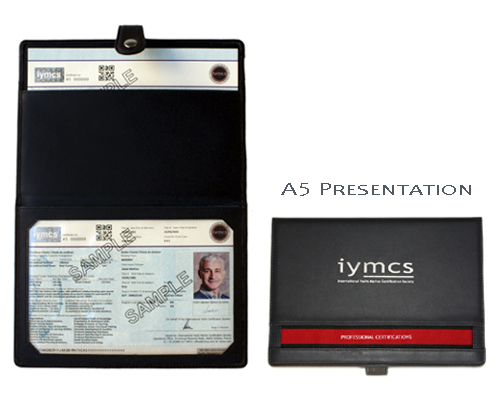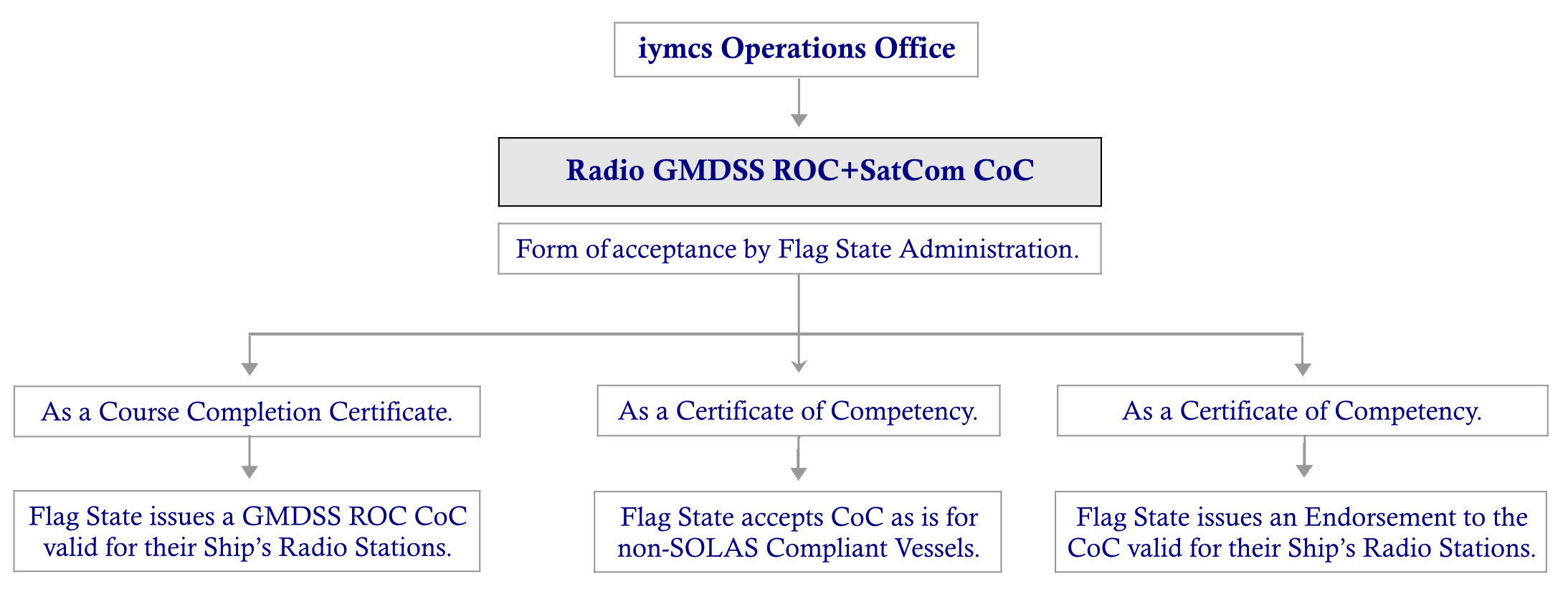
| General Details |
|---|
| Course & Certification:
ID: 6.3.2 Description: Radio GMDSS Restricted Operators Certificate + SatCom. Certification type: Certificate of Competency ISO 9001:2015 compliance course & certification. |
| Course Length:
A total of 58 hours consisting of; Pre-Course study = 2 hours. |
| Capacity of certification:
Crew manning SOLAS compliant or voluntary compliance vessels & yachts <300GT: Crew manning private registered vessels & yachts <500GT: Frequency Bands: |
| Recognitions & approvals:
This Certificate is principally a course completion certificate, it needs to be presented to the Flag Administration of the vessel and it’s radio station, for them to issue their own Restricted Operator’s Certificate or issue an Endorsement to this Certificate. Certificate recognised by all CEPT countries which have adopted CEPT/ERC/DEC/(99)-01. |
| Reference Standards:
Radio GMDSS Restricted Operator's Certificate for SOLAS Compliant Vessels & Non-SOLAS Vessels. |
| Certification Revalidation:
Required every 5 years. |
| Sea-time requirements:
None. |
| Certification issuing requirements:
None. |

The custom-designed iymcs presentation folder type certification is stylish and practical.
The presentation folder outer is made of real leather with a sythentic interior that is resistant to water and protects the certificates.
It is A5 in size, it can hold up to four Certificates, and is an ideal size to be kept in a crew document case or with the boat's documents.
The iymcs Certificates are printed to ISO9001:2015 standards, are dual-language and feature extensive security features
to security level 3 (Government passports & national Iidentification documents are security levels 1 & 2) and can be used as a personal ID in daily situations.
(Nb. It cannot be used instead of a passport/national identity card).
Under the STCW and GMDSS Conventions, it is a requirement for all crew to be qualified as a Radio Officer or hold either the ROC (Restricted Operators Certificate) or the GOC (General Operators Certificate), to enable them to operate GMDSS Radio Equipment carried on-board commercial vessels, fishing vessels, classic sail vessels or super-yachts engaged in charter. This requirement is a fundamental principle of the SOLAS Convention.
The iymcs Radio GMDSS Restricted Operators Certificate (ROC) + SatCom course covers the training requirements for the Restricted Operators Certificate holders operating in Sea Area A1. In addition, the syllabus has been extended to cover MF requirements for Sea Area A2 as well as incorporating the syllabus for GMDSS L-Band Satellite operations of Inmarsat C and Iridium GMDSS.
The reasons for this are:
1. Many of the private-registered super-yachts under 300GT, operate regularly in Sea Area A1 & A2. They often carry L-Band Satellite and some, Marine SSB MF/HF Radio Telephones.
2. The Search & Rescue Regions of some Maritime Administrations are so big that often the Sea Area A1 is not designated. That is to say, in many coastal regions, they are designated as Sea Area A2 from a coastline. The communication distances within these sea areas are often beyond the DSC Tx/Rx range capabilities of the Marine Radio VHF.
3. Satellite communications play a significant part in Distress & Urgency situations once beyond Marine VHF range.
4. There are sea areas that experience very poor sea conditions and meteorological conditions on a regular basis. In such sea areas, communications via Marine VHF can often be limited to a short horizon distance of just 4 Nm to 5 Nm. Marine SSB MF and/or L-Band Satellite is essential to extend communication ranges of both voice and DSC.
This comprehensive course focuses upon; the SOLAS requirements, GMDSS organisation and structure, the 7 elements of GMDSS, comms protocols & phrases, the operating procedures for Distress, Urgency & Safety communications, Medical communications, SAR organisation and radio equipment & maintenance.
The subjects are covered in-depth and the operating procedures are shown with scenarios and responses to, focusing upon SOLAS requirements.
Certification Structure:
This Certificate is principally a Course Completion Certificate, it needs to be presented to the Flag Administration of the vessel and it’s radio station,
for them to issue their own Restricted Operator’s Certificate or issue an Endorsement to this Certificate.


Our Society, the 'International Yacht Marine Certification Society" (iymcs) operates its entire operations under a Quality Management System
(QMS) that is in compliance with the International Standards Organisation (ISO) 9001:2015 amended. Part of this compliance involves full auditing procedures.
This is an important reference and enables us to gain recognitions from maritime administrations and marine industry bodies alike.
The QMS together with the ISO, ensures that iymcs and its Members operate to the highest standards possible. All our courses, and more importantly the
Certifications that we issue, are under ISO9001:2015.
This practice is most unusual for such courses and certifications. Some organisations will claim ISO:9001
adherence but often the reality is the ISO compliance is for a very small number of their courses.
| Scandinavia 750,-EUR | Northern Europe 650,-EUR | United Kingdom 600,-GBP |
| Southern Europe 550,-EUR | Middle East 650,-USD | North America 490,-USD |
| Prices exclude: course books,certification costs,personal traveling costs,course food and course accommodation. | ||
( Vers. 1.0. CEPT/ERC.) Click-on '+' to see Syllabus.
Science of radio waves (A1.1.3. Radio wave propagation (A1.1.3). Ground waves and sky waves propagation (A1.1.3). Tx & Rx ranges (A1.1.3). Marine VHF Radio Telephone installation (B3.3.2 & 3.3). Interfacing connection to a positioning device (B3.3.2). GMDSS, ITU & SOLAS. Distress Mayday -history and background of.
GMDSS Structure (A2.2.1). GMDSS Sea areas (A2.2.1). SAR Organisation (A3.3.3). MRCC & MRSC (A3.3.2)..
Radio frequency and bands. Simplex, Semi-duplex & Full-duplex operations (A1.1.3). Transmission and receiving distances (A1.1.3). Types of Communications (A1.1.1). Channel types, Categories & Usages (A1.1.3).
Types of Aerials. Antenna performance & positioning. (B3.3.1). Antenna Gain. MF/HF Antenna Installation. Types of Antenna. Antenna Interfacing Units. WiFi Antenna Group. Standing Wave Ratio Meter. Satellite Parabolic Antennas. Lightening.
Marine VHF Radio - Mobile Station Units (B1.1.3). Marine VHF Radio - Handheld Units (B1.1.3). Marine VHF Radio - GMDSS SOLAS Survival Craft Radio. On-Board Radio UHF - Handheld. Marine Headsets & Mics. Satellite Communication Phones - Handheld & Mobile Units. DSC Controller Units & Classes. Inmarsat C & Iridium GMDSS. NAVTEX, Fax & Telex. Emergency Position-Indicating Radio Beacon (EPIRB) (C3.3.1 + C2.2.6 + C3.3.2). MOB Personal Location Beacon (PLB). Search & Rescue Transponder (SART) (C3.3.2 + C3.3). Marine SSB MF/HF Radio. GMDSS Radio Station Equipment Installations.
DSC - History & Development. Maritime Mobile Service Identity Number (MMSI). National ID - Maritime Identification Digits (B2.2.3). MMSI N°s - Ship Station (B2.2.3). MMSI N°s - Coast Station (B2.2.3). MMSI N°s - Group Call (B2.2.3). MMSI N°s - EPIRB AIS & SART AIS Beacons. MMSI Resources.
SafetyNET - Information Network & Structuring. SafetyNET - NAVAREAS & METAREAS. SafetyNET - Types of Addresses. Maritime Safety Information - Message Categories. Maritime Safety Information - Resources.
AIS - System. AIS - Channel & Frequency Allocation. AIS - On-Board Equipment & Installation. AIS - Transceivers, Transponders & Receiver Units. AIS - Principal Functions & Cautionary Points. AIS - Data Transmissions. AIS - Data Error & Implications.
Satellite GMDSS Overview. Inmarsat - History & Organisation. Inmarsat - Footprint & Enhanced Group Calling. Inmarsat - C, Mini C & Fleet. Iridium - History & Organisation. Iridium - Satellite Network. Iridium - GMDSS. Iridium - Enhanced Group Calling. SatCom Phones.
Ships Radio Station Licences. Radio Operator Certifications (E1.1.2). Types of Radio Stations (A1.1.2). ITU International & Regional Channel Lists (E1.1.2). ITU/GMDSS Regs. of Operations & Good Practices. (E1.1.2). Vessel Identification (D2.2.1) & MMSI (B2.2.3). Radio GMDSS log (E1.1.2). Voyage GMDSS Communications Plan.
Official ITU & GMDSS Publications. International Code of Signals. Independently Published Yacht; Cruising Guides, Pilot books, Charts. UKHO Admiralty Sailing Directions. Electronic Chart Plotters (ECS) Information Inserts/Boxes. Official Online Internet Resources.
Principal Controls (B1.1.2). Initial Switch-On & Operator Procedure. Power Outputs. Dual-Watch, Tri-Watch & Scan-Watch (B1.1.1). Channel 16 (A1.1.3). Primary International Channels (A1.1.3). VHF Channels & Frequencies (A1.1.3). Adverse Meteorological Conditions. DSC System, Alert & Messaging DSC (B2.2.2 & B2.2.4).
Marine SSB MF/HF Communication Principals. Frequency Band Comm Ranges. Principal Controls (B1.1.2). Dual-Watch, Tri-Watch & Scan-Watch (B1.1.1). Class of Emissions. Initial Switch-On & Operator Tx Procedures. Guard Channel 2.182.0 MHz (A1.1.3). Guard Channel 2.187.5 MHz. Primary International Channels (A1.1.3). MF Channels & Frequencies (A1.1.3). Marine SSB DSC Controller. Rx Operator Procedures. Narrow Band Direct Printing (NBDP). Email Interface.
The International Phonetic Alphabet (D1.1.5). International Marine Communications Procedure Words (D1.1.4). Communication Phrases Exercises. Phonetic Alphabet Exercises.
Com procedures -ship to ship (B2.2.1 & D2.2.1). Com procedures -ship to MRCC or MRSC (A3.3.4 & D2.2.1). Com procedures -ship to coast station (D2.2.2). Com procedures -ship to VTS Control station (D2.2.2). Com Procedures -ship to Aircraft station. Traffic Lists. Traffic Charges (D2.2.3). Radio Procedures Cards.
The Col.Regs (IRPCS). Efective Communication Criteria. Ship-to Ship Procedure. Specific Procedure Words & Phrases.
On-board Communications - UHF Handheld (C3.3.3). Tender/Auxiliary Communications - VHF Handheld & Fixed (C3.3.3). Communication On-Board Ranges (C3.3.3). Battery Provisions (C3.3.3). Message Relay.
Distress Mayday Situation - Definitions. Distress Mayday Situation - Determining. Distress Mayday - Alert & Message Content (B2.2.1 & C1.1.1). Distress Mayday - Tx Procedures (C1.1.1). Distress Mayday - Response Procedures (A3.3.4 & C2.2.2). Distress Mayday - Relay Procedures (A3.3.4). Distress Mayday - Cancellation Procedures. Obligation to Assist a Vessel, Aircraft or Person/s in Distress. Urgency Pan Pan - Definitions. Urgency Pan Pan - Tx Procedures (B2.2.1 & C1.1.2). Urgency Pan Pan - Response Procedures (A3.3.4). Urgency Pan Pan - Cancellation Procedures.
Reference Publications. Telemedical Advice Services (TMAS). TMAS Assistance - Patient Information. Medical Advice - Standard Phrases. Urgency Pan Pan (Medico/Medical) Message - Tx Procedures (D1.1.2).
Safety Sécurité Message - categories (D1.1.3). Safety Sécurité Message - content (B2.2.1 & D1.1.3). Safety Sécurité Message - Rx & Tx procedures Safety (C1.1.2 & D1.1.3).
NBDP Principles (A4.4.1). Message Format & Categories (A4.4.1). Messages which cannot be rejected (A4.4.1). Message Record Keeping. NAVTEX Stations & Frequencies (E1.1.1). Installations. Set-Up & Operating Procedures (A4.4.1).
The L-Band GMDSS Satellite Systems. Maritime Safety Service Activation Form (MSSAF). Two-Digit Urgency & Safety Codes. Power Supply Requirements. Ship Security Alert System (SSAS). Billing Arrangements. Long Range Tracking & Identification (LRIT).
Marine VHF Channel Development. Frequency Guard Bands (C2.2.1). Guard Frequencies & Avoidance of Transmissions (C2.2.1 & C2.2.5). Test Protocols & Procedures (C2.2.4). Cancellation Procedures for False Distress Alert Transmitted (C2.2.6). Distress & Urgency Channel 16 Frequency Blocked. Prevention of Unauthorised Transmissions (C2.2.3).
Installation & Power Sources (B3.3.3). Battery Management & Charging (B3.3.3). Battery Confguration. Battery Types & Maintenance (B3.3.3). Safety Requirements (B3.3.3). Basic Electrical Circuit Testing. Equipment Certificates